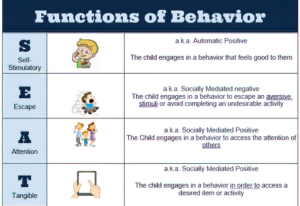If you were able to view our previous blog, you’ll recall that there are 4 basic functions of behavior, as shown in this chart below:
https://successonthespectrum.com/wp-admin/user-new.php

Self- Stimulatory Behaviors
The first function of behavior we will discuss is Self-Stimulatory. This is the “feel good behavior.” These are behaviors that occur simply because it feels good to the individual, or is perhaps a habit. We all engage in self-stimulatory behaviors to some extent. For example, some people twirl their hair when nervous; others might bounce their knee while sitting down. The most important component of this function is that the behavior itself is reinforcing. This means that no person or situation is causing the behavior to keep occurring; it occurs simply because the child enjoys it. These behaviors may occur most often during down time, when the child is not doing anything else or is doing a mindless task, such as watching TV.
It is important for parents, teachers and therapists to all remember this fact. It is common for us to sometimes hyper-analyze the children in our lives with autism, worrying about their various self-stimulatory behaviors. Let’s all remember that they are children first! Children often do strange things- they are still growing and exploring their body and their environment.
When to Intervene
We do not always recommend that parents and therapists intervene when a child is engaging in a self-stimulatory behavior. This may be a calming mechanism for the child or help them regulate their body! I would get frustrated if someone stopped me from messing with a fidget while I was talking, which is my self-stimulatory behavior! There are 3 occasions in which we recommend intervening for these behaviors:
1. The behavior causes harm or can potentially cause harm to the child or others- this may include self- hitting, self- biting or throwing objects
2. The behavior is impeding the child’s ability to engage socially in this moment- the child has the foundational skills needed to engage socially, but is choosing to engage in the self-stimulatory behavior instead or is causing peers to walk away
3. The child is preparing to go into the general education classroom and the behavior would cause major disruptions in the classroom- this may include singing to oneself, talking aloud to oneself, etc.
How to Intervene
Once you determine it is necessary to intervene to stop the self-stimulatory behavior, we now have to learn what is the best way to intervene. When your child engages in a self-stimulatory behavior that requires intervention, the simplest way to intervene is to redirect to another neutral activity. In short, give them something better to do!
Here are some tips on how to do this:
– Hand them the alternate activity- do not grab their hands and force them to engage with the item. Simply offer it to them.
– Neutral- a neutral activity is one that is not reinforcing to the child (e.g. it is not their favorite toy) but is also not considered “work” for the child.
– Known- this activity should be something the child knows how to interact with. So do not give them a puzzle if they do not know how to do puzzles
– Incompatiable (when possible)- This means that the child cannot continue to do the behavior and engage in the new activity. For example, if the child is hitting his head, then giving him something else to do with his hands, such as hitting a drum or putting together Mr. Potatohead. If the behavior is vocal, such as screaming, try to have them answer questions, engage in a conversation or talk to you (if they are able to verbally communicate). Please note, if your child does not verbally communicate but engages in vocal behavior (e.g. screaming), redirecting them to another physical activity can still be helpful.
The key to self-stimulatory behaviors is to remember we all do them! Our children with autism may just engage in ones that are less socially typical. Intervene only when needed, using gentle redirection.
All of our interventions should be gentle and demonstrate respect for our children!


